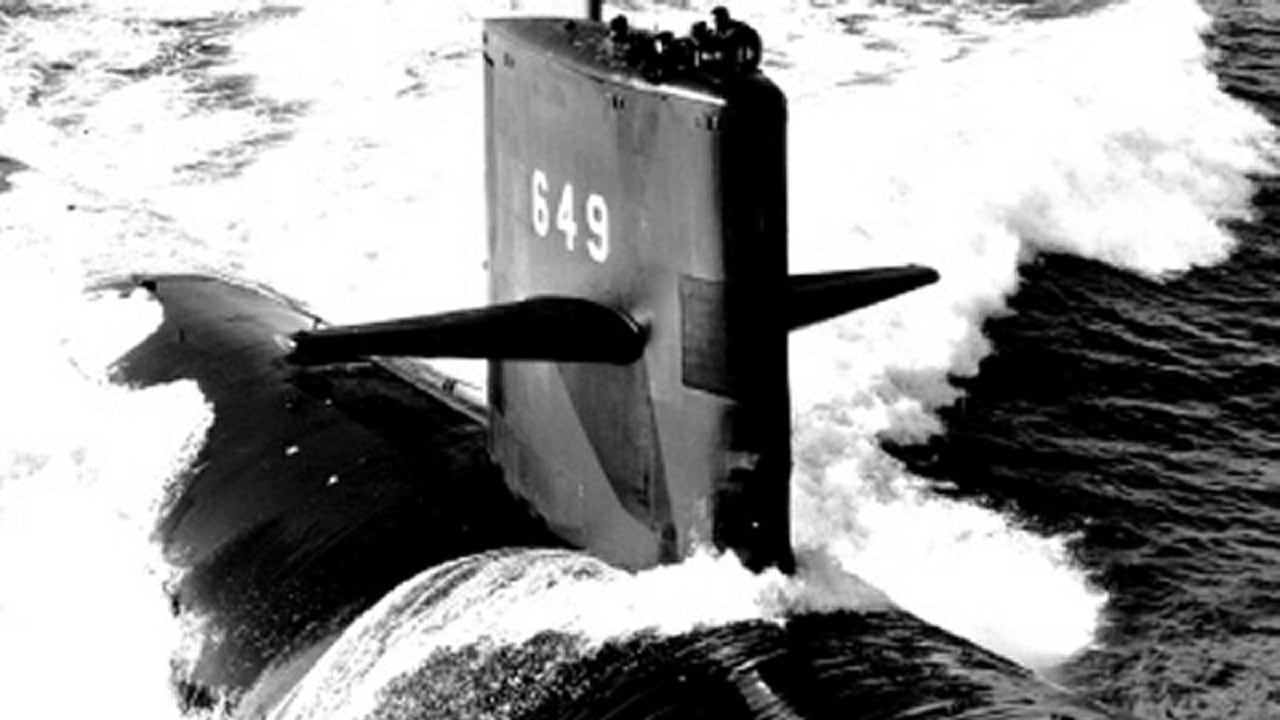On May 15, 1969, the then still-under-construction Sturgeon-class nuclear-powered attack submarine USS Guitarro sank while undergoing her fitting out at the Mare Island site of the San Francisco Bay Naval Shipyard. She was reportedly scheduled for commissioning sometime in 1970.
According to the Chronology of Events set out in the official report, the incident occurred as a civilian construction group (nuclear) began an instrument calibration assignment that required the filling of certain tanks, which were located aft of the ship’s pivot point, with approximately five tons of water. Another civilian construction team (non-nuclear) just a half hour later began an assignment to bring the ship within a half degree of trim. That apparently entailed the adding of water to tanks forward of the ship’s pivot point, to overcome a reported two-degree up-bow attitude.
The nuclear group continued to add water aft, while the nonnuclear group continued to add water forward. Things appeared to be going according to schedule, but already problems were developing.
The official report stated, “A security watch advised the nonnuclear group that by that time the Guitarro was riding so low forward that a one and a half foot wave action, stirred up by boats operating in the river, was causing water to enter an uncovered manhole in the most forward and lowest portion of the ship’s deck. These warnings went unheeded.”
At approximately 7:45 pm local time, the nonnuclear group stopped adding water to the ballast tanks in preparation for their lunch break. The nuclear group then completed its calibrating assignment and began to empty the tanks aft. Just over an hour later, as the nuclear group continued to empty the water from the aft tanks a member of the group noticed a “sudden down angle being taken by the boat.”
At approximately the same time, the nonnuclear group and others began to return to the ship from their lunch break and arrived to observe the boat down sharply at the bow with massive flooding taking place through several large open hatches. Efforts made to close watertight doors and hatches were unsuccessful due to lines and cables running through them.
At 8:55 pm, the USS Guitarro sank, the inquiry further noted.
The official report, compiled from over 600 pages of testimony, concluded that the immediate cause of the sinking was “the culpable negligence of certain shipyard employees,” which was further coupled with “inadequate coordination of both the ship construction activities and the assignment of specific responsibilities.”
It was also determined, “The Guitarro should not have sunk. It was not overwhelmed by cataclysmic forces of nature or an imperfection in design or an inherent weakness in its hull. Rather, it was sent to the bottom by the action, or inaction, of certain construction workers who either failed to recognize an actual or potential threat to the ship’s safety or assumed that it was not their responsibility. Certainly, the tragedy was not caused by any lack of formal directives. Over 300 pages of instructions, guidelines and organizational charts meticulously detailed and parceled out responsibilities and authorities.”
Returned to Service
Three days later the boat was refloated, with damages estimated at between $15.2 million and $21.85 million. After a 32-month delay, the nuclear-powered submarine was finally commissioned in January 1970. However, the “Mare Island Mud Puppy” – as she became known – suffered two other accidents in her career.
In May 1984, a fire broke out on board the boat during a training exercise. Officials found that the fire originated in the submarine’s battery well due to heat from electrical discharge on one of the cells, while just over two years later SSN-665 suffered a minor mishap involving a shipboard valve while at sea.
Those were minor mishaps, however.
Testbed for Tomahawks
During the boat’s service history, she served as a primary testbed for Submarine Launched Tomahawk Cruise Missile testing from 1977 through 1984. A number of tests were employed, paving the way for the use of the missiles on the U.S. Navy’s Ohio-class submarines.
USS Guitarro remained in service until 1992, while recycling of the submarine was finished on October 18, 1994.
As the Naval History and Heritage Command noted, while the boat’s “birth had earned her the sort of notoriety that most submariners shun, for the most part, her life in the ‘silent service’ was one of quiet distinction.”
That included “contributing to the development of the Tomahawk, providing ASW services, or conducting missions that will forever, by their very nature, remain among the mysteries of the Deep, known to only those who carried them out.”
Author Experience and Expertise
A Senior Editor for 19FortyFive, Peter Suciu is a Michigan-based writer. He has contributed to more than four dozen magazines, newspapers, and websites with over 3,200 published pieces over a twenty-year career in journalism. He regularly writes about military hardware, firearms history, cybersecurity, politics, and international affairs. Peter is also a Contributing Writer for Forbes and Clearance Jobs. You can follow him on Twitter: @PeterSuciu.
From 19FortyFive
Total Massacre’: Ukraine Footage Shows Russian Cruise Missile Shipment Attacked
Video – Ukraine Has Massive New NATO ‘Cannon’ Ready To Fight Russia
‘Americans Will Pay The Price’: One Democrat Is Angry At Joe Biden

